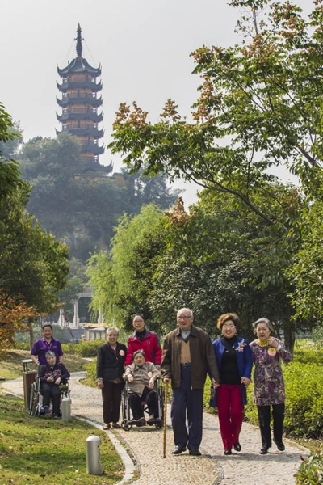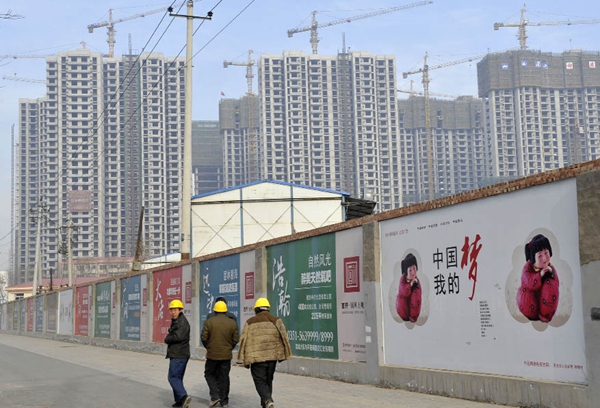China’s New Vision for the Next Five Years
China today by staff reporter TANG SHUBIAO, May 5, 2016 Adjust font size:
Thousands of representatives from across the country gathered in Beijing on March 5 for the Fourth Session of the 12th National People’s Congress (NPC) to review China’s 13th Five-Year Plan. It created for the country a brand new blueprint.
Economic Aggregate: RMB 92.7 Trillion
The plan states that by the year 2020 China’s GDP will, on the foundation of balance, inclusiveness, and sustainability, reach RMB 92.7 trillion – a solid material basis on which to comprehensively build a moderately prosperous society.
In 2010, China’s GDP surpassed Japan’s, so making it the world’s second largest economy. From 2010 to 2015, China’s GDP grew from RMB 40.9 trillion to RMB 67.7 trillion. China is now the motive power of the world economy, according to senior economist at Japan’s NLI Research Institute Tsuyoshi Ueno.
 |
|
The A330 Completion and Delivery Center at the Airbus Tianjin facility in Tianjin Municipality starts operations on March 2, 2016. |
Taking various factors into consideration, China must in the coming five years maintain medium-to-high economic growth – an annual average growth of no less than 6.5 percent – to realize its growth target. Under the current situation, setting an overly high target is inadvisable, according to Professor Bai Chongen of Tsinghua University. One of 6.5 percent and above is both realistic and necessary. “The 6.5 percent figure is the bottomline of China’s GDP growth for the next five years, and an achievable goal,” Chinese President Xi Jinping said. Xi believes that the focus of economic development should be on speed, increment and quality. Efforts should also be made to achieve quality, efficient, authentic, and sustainable economic gains. Xi regards medium-to-high growth as one of the three features of the “new normal” of China’s economy.
Per Capita Income Growth: 6.5 Percent
China will, the plan states, make great efforts to surmount the middle-income trap. Therefore, the per capita income of urban and rural residents must by 2020 double that of 2010. This is an important indicator in achieving a moderately prosperous society, and entails maintaining a per capita income growth from 2016 to 2020 of more than 6.5 percent.
According to World Bank standards, the term “middle-income countries” refers to nations with a per capita GDP of US $10,000. In 2015, China’s per capita GDP was US $7,924. If an annual growth of 6.5 percent is maintained, the figure in five years’ time will exceed US $10,000, so attaining the level of a moderately developed country.
The next five years are crucial to China’s avoidance of the middle-income trap, which necessitates rapid development of the real economy, according to head of the State-owned Assets Supervision and Administration Commission Zhang Yi.
Economist Jiang Kang believes that accelerating economic transformation and upgrading during the next five years is imperative if the country is to escape the potential menace of this trap.
Professor Cai Jiming of Tsinghua University believes that income distribution should be improved. Also that, in addition to highlighting efficiency and justice, it is necessary to coordinate employment expansion and price stabilization with a sound monetary market, so delivering to the people the feasible benefits of economic development and higher incomes.
Life Expectancy: 77 Years Old
The plan proposes carrying out the Action Plan for the Health of China, which entails universal access to fundamental healthcare and services, promoting national fitness, improving people’s health, and increasing by one year the average life expectancy.
 |
|
China’s first LEGOLAND Discovery Center opens in Shanghai on April 7, 2016. |
China’s average life span in 2015 was 76 years old, the same as that of high- and middle-income countries. To increase it by one year China must invest more in medical treatment and senior care.
Achieving this goal calls for national, thorough-going health education and promotion, popularization of a healthy lifestyle, strengthened comprehensive control of serious diseases, protection of focus groups, and building a healthy production and living environment. Moreover, the construction of a medical and health service system should be strengthened to transform service modes, and improve service, so ensuring the people’s health.
Aging Population: 15 Percent
The plan proposes beefing up top-level design and establishing a system to deal with the aging population by constructing a better population strategy, employment system, elderly care and social and health security system, and through talent cultivation, environmental support, and social participation.
China now has more than 200 million people aged over 60, accounting for 15 percent of its population. This signifies the onset of the aging society. “Senior care involves everyone, and is a problem that needs to be solved urgently. The 13th Five-Year Plan presents an ideal opportunity to deal with this issue,” director of Shaanxi Provincial Development and Reform Commission Fang Weifeng said.
 |
|
Senior citizens from a local care home enjoy a stroll through Zhenjiang Jinshan Park in Jiangsu Province. |
Senior medical services remain deficient in many places in China. The number of patients suffering from senile dementia has risen over the past few years, and many must wait weeks before they can be hospitalized due to the lack of hospital beds, according to director of the Psychological Department of Beijing Geriatric Hospital Zhang Shouzi. The government has taken a number of measures, including encouraging the integrative development of medical and health institutions and pension services to ensure that senior citizens receive regular care.
President Xi Jinping holds that dealing effectively with the aging population is a matter of national concern, and affects the people’s well-being. He urged the government to perfect fertility, employment, elderly care and other major policies as a rational solution to this problem.
Poverty Alleviation: 70 Million
The 13th Five-Year Plan lays down targeted poverty alleviation measures that ensure the rural poor have adequate food and clothing, as well as access to basic education, health care, and housing security.
Xu Shaoshi, chief of the National Development and Reform Commission – China’s top economic planner – believes that helping people shake off poverty and rehabilitating poor counties is at the root of improving people’s livelihood. Since the implementation of the reform and opening-up policy 37 years ago, China has witnessed economic prosperity and significant social progress. The 70 million people it has lifted above the poverty line made a substantial contribution to the UN Millennium Development Goals, a feat that UN Under-Secretary-General and UN-Habitat Executive Director Dr Joan Clos described as an unprecedented achievement.
The upcoming five-year period will be the decisive stage in China’s building of an all-round moderately prosperous society. China will help 30 million people to rise above the current poverty line through characteristic industries, 10 million poor to find employment, and relocate 10 million poverty stricken residents from inhospitable areas. The 20 million or more impoverished people with disabilities will receive allowances as part of the safety net.
As at the end of 2014, there were still 70.17 million rural residents living below China’s poverty line of an annual income of RMB 2,300 (2010 constant price), or RMB 2,800 (2014 current price).
The Chinese Peasants and Workers Democratic Party is one of the eight non-communist political parties that participate in China’s state affairs. Zheng Xiaoyan, head of the party’s Jiangxi provincial committee, holds that China’s poverty relief campaign is one of a kind. “Poverty alleviation efforts, together with new industries such as e-commerce, photovoltaic industry and rural tourism, will become new points of economic growth,” Zheng said.
New-Type Urbanization: 300 Million
The plan lays down that by the year 2020, the urbanization rate will reach 60 percent in terms of regular residents and 45 percent in terms of registered residents. To achieve this, it is imperative to speed up new-type urbanization and the resettling of around 100 million rural workers and regular urban residents. Accelerating reconstruction of urban shanty towns, where 100 million people subsist, is also crucial. Around 100 million people in central and western China are encouraged to move to cities and towns close to their rural homes.
Chinese President Xi Jinping believes that resettling 100 million people in urban areas is of great social and economic significance. From the supply perspective, under the current situation of a reduced working-age population, cultivating modern industrial workers and stabilizing the labor force and its costs is an urgent matter. As regards expanding consumer demand, it is moreover necessary to stabilize the real estate market and expand investment in urban infrastructure and public facilities. Achievement of this goal is conducive to steady economic growth, social harmony, fairness, and justice, which are at the core of building an all-round well-off society. The reform of the household registration, or hukou, system in 2015 laid a solid foundation for the development of new-type urbanization.
“It will be easy to achieve 60 percent urbanization of regular residents by 2020, but to realize 45 percent urbanization in terms of the hukou, we must strengthen reform and increase public financial investment,” researcher at the Urban Development and Environment Research Institute of Chinese Academy of Social Sciences Liu Zhiyan said. New urbanization will bring about changes in socio-economic development, and also promote consumption and investment. It is hence the largest potential driver of domestic demand and development.
Sci & Tech Innovation: 6+9
The plan specifies that development stems from innovation. Promoting technological innovation by combining it with mass entrepreneurship and innovation, therefore, will generate development momentum and technological support sufficient to build a comprehensive well-off society. By 2020, R&D budgets will account for 2.5 percent of GDP, and scientific progress will contribute 60 percent to economic growth.
In 2015, China launched the strategy of innovation-driven development, the mass entrepreneurship and innovation policy, the Internet Plus Action Plan and Made in China 2025 strategy, all of which achieved gratifying results. The 13th Five-Year Plan will initiate the key Scientific and Technological Innovation 2030 Project that comprises six major items. They include aero-engines and gas turbines, a deep sea station, quantum communication and quantum computers, and brain sciences and research. The project also encompasses nine other sub-projects, including an innovative seed industry, a smart grid, a space-terrestrial information network, intelligent manufacturing, and robots.
“These projects identify and embody the issues that the scientific community acknowledges as important and critical to the country’s needs, and their application will show that China has the ability to meet world-class challenges and fuel its industrial development,” neurobiologist, academician of Chinese Academy of Sciences, and director of the department of medicine with Zhejiang University Duan Shumin said.
New Energy Vehicles: 5 Million
The plan promotes new energy vehicles. By the end of 2020, a total of five million new energy vehicles will have been sold. The plan also encourages new energy buses and taxis, and promotes electric autos and hybrid vehicles.
Over the past two years, new energy vehicles, from R&D to technology, have seen significant improvements thanks to supportive national policies and the hard work of relevant parties. Both production and sales are on the rise: in 2015 the former reached 340,471 and the latter 331,092. However, there is still a long way to go before the 2020 goal can be reached.
The State Council decided last February to promote green development by improving its structure, and so launched five measures to further support the new energy auto industry. Zhang Tianren, president of the Tianneng Group, holds that development of a new energy auto industry is a focal point for China’s cultivation of new economic drives, and hence an important aspect of the country’s economic transformation and green development during the 13th Five-Year Plan and beyond.
Transformation and Upgrade Projects: 8
The plan specifies that economic restructuring be promoted through implementation of projects in eight key areas. They include finance, agriculture, high-end equipment, strategic emerging industries, informatization, new-type urbanization, in special regions, and the ocean.
Strategic emerging industries range from 5G, advanced sensors, and wearable devices to genomic translating techniques and remote sensing satellites, all of which are expected to be incorporated into large-scale and commercial applications. Professor Cai Jiming from Tsinghua University holds that strategic emerging industries will help China’s transition from the traditional to modern development drive, and so enable the country to secure competitive advantages over others in future.
“Implementing the big data initiative contributes to industrial upgrading and better social governance. Ultimately, it helps ordinary people live an easier life,” Vice President and Secretary-general of the Chinese Institute of Electronics Xu Xiaolan said.
Ecological and Environmental Projects: 19
The plan highlights environmental quality as a core issue, and vows to enhance protection of the ecological environment and improve the efficiency of resource exploitation.
There have been great achievements in ecological protection over the past five years. But even though the previous goals of energy conservation and emissions reduction have been reached, even surpassed, the situation remains severe in light of the state of the environment and the people’s expectations. Deputy Director of the Hunan Provincial Environmental Protection Bureau Pan Biling believes that the old path of post-pollution management must be abandoned, and a beautiful China of blue skies, green lands and clean water built.
In the next five years, China is expected to launch 19 major projects in the sector of ecological environment. They include five in the fields of energy conservation and recycling, six concerning environmental rehabilitation and protection, and eight that will mend the eco-systems of mountains, lakes, rivers and forests. “The focus of these projects should be on urgent ecological and environmental issues. They should, therefore, be clearly aimed at concrete issues,” Pan Biling said. Vice President of Beijing-based China University of Mining and Technology Jiang Yaodong believes that implementing these big projects can achieve the goal of green production over the next five years.
Good Air Quality Days: 292
The 13th Five-Year Plan proposes to extend natural gas pipelines in pivotal areas to curb air pollution and reduce China’s water consumption per unit of GDP by 23 percent, of energy consumption per unit of GDP by 15 percent, and of carbon dioxide emissions per unit of GDP by 18 percent. This will enhance efficient utilization of energy resources and the quality of the ecological environment as a whole, and achieve atmospheric haze control by 2020. The ultimate goal is to achieve, at prefecture level and above, more than 292 days of good air quality throughout the year. The plan also sets out to reduce the concentration of PM2.5 in the coming five years.
China’s cumulative energy conservation over the past two decades has contributed 58 percent to the global total. Meanwhile the country’s renewable energy installed capacity accounts for 24 percent to 25 percent of the global increment, and its increment in recent years for 37 percent to 42 percent. China was the first developing country to raise the concept of Intended Nationally Determined Contributions (INDC), and to commit to reaching peak emissions around the year 2030.
Xia Yujie, director of Anhui Zhongding Holding (Group) Co., Ltd., observed that although the country has previously set emission reduction targets, it has now committed to the specific objective of improving the environment for the public good. Tianjin municipal government counselor Bao Jingling pointed out that the 13th Five-Year Plan incorporates a stringent PM2.5 index, so demonstrating government confidence in its ability to combat environmental pollution. He added that local governments should give priority to improving the environment. China’s Special Envoy on Climate Change and former Vice-chairman of the National Development and Reform Commission Xie Zhenhua commented that China’s adoption of multiple energy-saving measures had reduced emissions, and that its achievements in energy conservation, improved energy efficiency, and development of renewable energy have brought it worldwide affirmation. It was thanks to China’s significant contributions that there was no increase in global carbon emissions in the year 2015.
Urban Commute: 1 Hour
The 13th Five-Year Plan proposes the building of a one-hour urban commuting circle in metropolitan areas between central cities and their main surrounding towns, along with an inter-city railway network linking city clusters in the Beijing-Tianjin-Hebei region, the Yangtze River Delta, the Pearl River Delta, the middle reaches of the Yangtze River, the Central Plains, the Chengdu-Chongqing region, and Shandong Peninsula. The operating mileage of high-speed railways will reach 30,000 kilometers and cover around 80 percent of major cities.
 |
|
Migrant workers walk past a real estate construction site in Taiyuan, Shanxi Province. |
“We are entering an era of city clusters dominated by central metropolises,” Hefei City Mayor Zhang Qingjun said. The one-hour urban commuting circle is expected to make communications between each city node more convenient, thus amplifying the leading role of central cities and at the same time alleviating traffic congestion.
The new target will also enable the transfer of non-national capital functions to Beijing’s periphery. Senior technician of national security design & assessment Zhu Liangyu agreed that this proposal is conducive to optimizing Beijing’s spatial distribution and radiation to its surrounding areas, and that it will contribute to coordinated regional development.
Streamline Administration and Delegate Power: 13 Items
The 13th Five-Year Plan sets development goals that will accelerate the transformation of government functions, streamline administration, and delegate power to lower authorities. The aim is to provide better public services and improve administrative efficiency, as well as stimulate market vitality and social creativity. The plan has formulated 25 indicators in four categories. They include economic development, innovation-driven development, people’s livelihood and welfare, and resource utilization and environmental protection. Among them, 13 indicators aim to constrain government intervention.
In 2015, China finally abolished non-administrative license examinations and approvals. The items of pre-approval business registration were reduced by 85 percent, which streamlined the process for both individuals and enterprises. Surging entrepreneurial enthusiasm at all social levels was moreover apparent in the daily average of 12,000 newly registered enterprises.
National Development and Reform Commission Chairman Xu Shaoshi holds that the constraint indicators are basically to ensure that the government abides by its responsibilities. The anticipation indicators are for the market and competitive arena in general. They are expected to achieve balanced, inclusive, and sustainable development. Chairman of Hubei Huitian Adhesive Industry Corporation Zhang Feng welcomed the new policy and the eradication in Xiangyang, Hubei Province, of administrative approval and enterprise registration service fees. This will promote private company development and bolster the local economy.